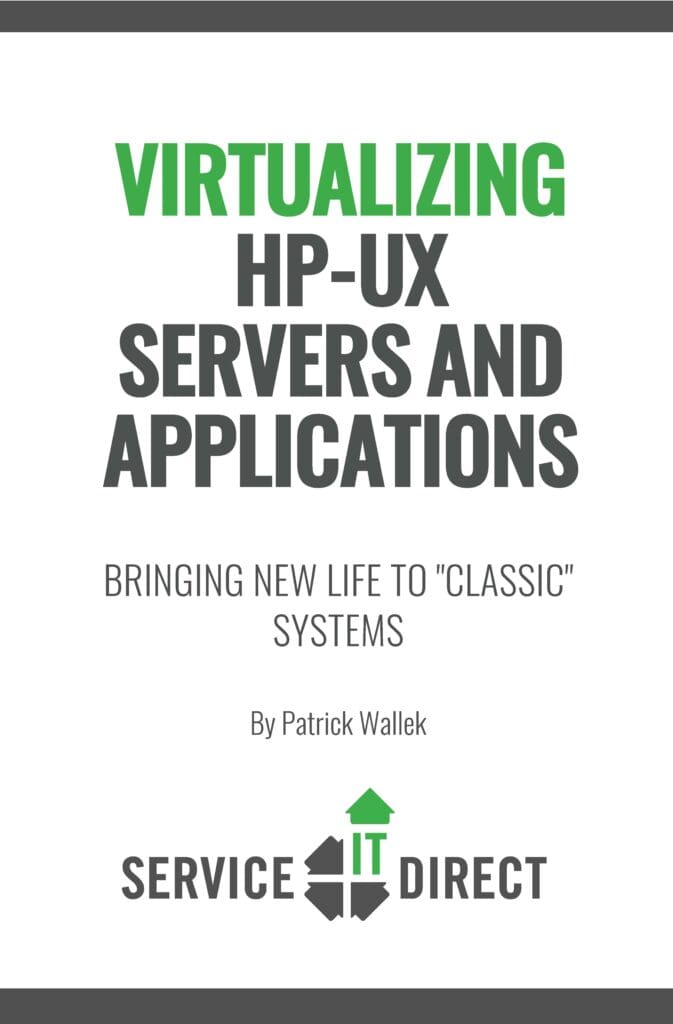Embarking on the journey to virtualize an HP-UX system opens up a world of possibilities for streamlining operations, improving efficiency, and enhancing overall server maintenance strategies. With the right guidance and tools, this process can be both transformative and rewarding. Let’s dive into the essentials of HP-UX virtualization and explore how to implement, optimize performance, and ensure secure operations in virtualized environments.
Understanding HP-UX Virtualization Essentials
Virtualization lies at the core of modern IT infrastructure, offering a way to run multiple operating systems on a single physical machine. In the realm of HP-UX, virtualization plays a crucial role in optimizing resources and enabling efficient server maintenance. By creating virtual machines, organizations can consolidate hardware, reduce energy consumption, and enhance disaster recovery capabilities.
One of the key components of HP-UX virtualization is the HP Integrity Virtual Machines (HP-IVM) software, which allows users to create and manage virtual servers on HP Integrity servers. This technology facilitates workload isolation, resource allocation, and system monitoring, making it a powerful tool for enhancing server maintenance practices.
Moreover, understanding the benefits of HP-UX virtualization is essential for organizations looking to modernize their IT environments. From improved scalability and flexibility to reduced operational costs, virtualization offers a range of advantages that can significantly impact server maintenance workflows. By embracing virtualization, enterprises can adapt to evolving business needs and optimize their infrastructure for future growth.
In summary, HP-UX virtualization provides a strategic framework for enhancing server maintenance operations, improving resource utilization, and enabling seamless scalability. By leveraging virtualization technologies, organizations can streamline IT management processes, boost productivity, and stay ahead in today’s dynamic digital landscape.
Implementing Virtualization Technologies on HP-UX
When it comes to implementing virtualization technologies on HP-UX systems, organizations must consider a range of factors to ensure a successful deployment. From assessing hardware compatibility to selecting the right virtualization software, careful planning is essential for seamless integration and efficient server maintenance.
The first step in implementing virtualization on HP-UX is to evaluate the existing infrastructure and identify the workloads that can benefit from virtualization. By conducting a thorough analysis, organizations can determine the optimal virtualization strategy to meet their specific needs and goals.
Next, selecting the appropriate virtualization software is crucial for maximizing the benefits of HP-UX virtualization. Tools like HP Integrity Virtual Machines (HP-IVM) and HP-UX Workload Manager (HP-WLM) offer robust features for creating, managing, and monitoring virtual environments, ensuring efficient server maintenance and optimal performance.
Furthermore, organizations should establish clear policies and procedures for virtual machine provisioning, monitoring, and security to maintain a secure and reliable virtualized environment. By following best practices and leveraging advanced virtualization technologies, organizations can achieve greater agility, scalability, and cost savings in their server maintenance processes.
In conclusion, implementing virtualization technologies on HP-UX systems requires meticulous planning, strategic decision-making, and a commitment to optimizing server maintenance workflows. By embracing virtualization, organizations can unlock new levels of efficiency, flexibility, and resilience in their IT operations.
Optimizing Server Performance through Virtualization
Virtualization offers a myriad of opportunities to optimize server performance and enhance overall efficiency in HP-UX environments. By virtualizing workloads, organizations can dynamically allocate resources, scale applications on demand, and improve system responsiveness, leading to a more agile and responsive IT infrastructure.
One of the key benefits of optimizing server performance through virtualization is the ability to achieve higher levels of resource utilization and consolidation. By running multiple virtual machines on a single physical server, organizations can reduce hardware costs, minimize energy consumption, and maximize the efficiency of their IT resources.
Additionally, virtualization enables organizations to implement advanced performance monitoring and management tools to ensure proactive maintenance and timely troubleshooting. By tracking key performance metrics, identifying bottlenecks, and optimizing resource allocation, IT teams can enhance server performance and deliver a seamless user experience.
Moreover, virtualization empowers organizations to implement disaster recovery and high availability solutions that protect critical workloads and data from unexpected disruptions. By leveraging virtualization technologies like live migration and failover clustering, organizations can ensure business continuity, minimize downtime, and enhance the overall reliability of their IT infrastructure.
In essence, optimizing server performance through virtualization is a strategic imperative for organizations seeking to achieve greater efficiency, reliability, and scalability in their HP-UX environments. By harnessing the power of virtualization technologies, organizations can unlock new levels of performance optimization and operational excellence.
Ensuring Secure Operations in Virtualized HP-UX Environments
Security is a paramount concern in virtualized HP-UX environments, where sensitive data, applications, and workloads coexist in shared virtualized infrastructure. To ensure secure operations, organizations must implement robust security measures, adhere to best practices, and stay vigilant against evolving cyber threats.
One of the key elements of securing virtualized HP-UX environments is the implementation of access controls, encryption mechanisms, and network segmentation to protect data integrity and confidentiality. By limiting access privileges, encrypting data in transit and at rest, and isolating network traffic, organizations can mitigate security risks and safeguard their digital assets.
Furthermore, organizations should regularly update their virtualization software, apply security patches, and conduct vulnerability assessments to identify and remediate potential security vulnerabilities. By staying proactive and responsive to emerging threats, organizations can strengthen their security posture and maintain the integrity of their virtualized HP-UX environments.
In addition, training IT staff on secure virtualization practices, enforcing security policies, and conducting regular security audits are essential steps to foster a culture of security awareness and compliance. By empowering employees with the knowledge and tools to detect and respond to security incidents, organizations can create a resilient and secure operating environment.
In conclusion, ensuring secure operations in virtualized HP-UX environments demands a comprehensive approach to cybersecurity, risk management, and compliance. By prioritizing security best practices, investing in security technologies, and fostering a culture of vigilance, organizations can protect their critical assets, maintain regulatory compliance, and build trust with stakeholders.
Embracing the Future of Server Maintenance
As we wrap up our exploration of virtualizing an HP-UX system, it’s clear that embracing virtualization technologies is key to efficient server maintenance practices. By harnessing the power of virtualization, organizations can unlock new levels of flexibility, scalability, and security. Remember, virtualization is not just a trend; it’s a strategic approach to maximizing resources and enhancing operational resilience. By staying informed and embracing innovation, you can navigate the ever-evolving landscape of server maintenance with confidence.


